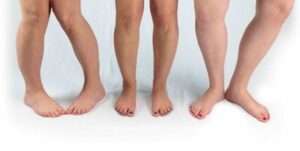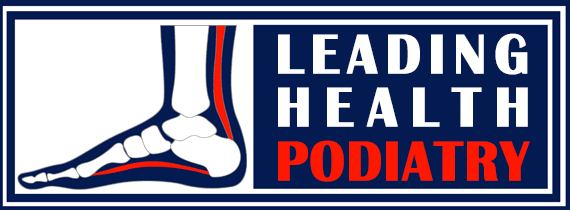Intoeing
Intoeing, commonly referred to as “pigeon-toed,” occurs when a child or adult’s feet turn inward while walking or running. This condition can affect one or both feet and may lead to difficulty with walking or balance. At Leading Health Podiatry, we specialize in diagnosing and treating intoeing, helping patients of all ages improve their gait and overall mobility.

Causes of Intoeing
Intoeing can be caused by several factors, including:
- Tibial Torsion: This is a condition where the shinbone (tibia) rotates inward, leading to the feet turning inwards. Tibial torsion is common in children and often improves as they grow.
- Femoral Anteversion: This occurs when the thigh bone (femur) is rotated inward, which can cause intoeing, particularly in young children.
- Metatarsus Adductus: A congenital condition where the front part of the foot curves inward, causing the toes to point inward. This condition can be present at birth and may require treatment.
- Muscle Imbalance: Weak or tight muscles in the legs can cause improper alignment of the feet, contributing to intoeing.
- Foot Structure: Certain structural abnormalities in the feet or legs can contribute to intoeing, affecting the way you walk or run.
Symptoms of Intoeing
The most common symptom of intoeing is the inward turning of the feet when walking or running. Other symptoms may include:
- Altered Gait: A child or adult with intoeing may have a noticeable “pigeon-toed” gait, which may cause stumbling or difficulty with balance.
- Pain or Discomfort: While intoeing typically does not cause pain, it may lead to discomfort in the knees, hips, or lower back due to the abnormal alignment of the legs.
- Worsening of the Condition: In some cases, if left untreated, intoeing can cause additional musculoskeletal problems, such as muscle strain or joint discomfort.
Diagnosing Intoeing
At Leading Health Podiatry, we perform a comprehensive evaluation to diagnose intoeing and its underlying causes. Our process includes:
- Physical Examination: We examine the alignment of your feet, legs, and hips to identify any abnormalities or misalignments contributing to intoeing.
- Gait Analysis: We observe how you walk to assess how the feet turn inward and its impact on your posture and balance.
- Imaging Tests: In some cases, X-rays may be used to evaluate the bones in the legs and feet to rule out other conditions that may contribute to intoeing.
Treatment for Intoeing
Treatment for intoeing depends on the severity of the condition and the underlying cause. At Leading Health Podiatry, we offer various treatments to help manage and improve the condition:
- Stretching and Strengthening Exercises: Targeted exercises can improve muscle balance and flexibility, helping to correct foot alignment and reduce the inward turning of the feet.
- Custom Orthotics: For some individuals, custom-made insoles can help realign the feet and improve overall gait, reducing the effects of intoeing.
- Footwear Recommendations: We may recommend specific types of shoes or modifications to help support the feet and improve posture during walking or running.
- Physical Therapy: For more severe cases, physical therapy may be necessary to address underlying muscle imbalances and improve coordination.
- Surgical Intervention: In rare cases, surgery may be required to correct structural issues in the legs or feet, especially if the condition does not improve with non-surgical treatments.
When to Seek Help for Intoeing
If you or your child is experiencing intoeing that seems to be affecting mobility, balance, or causing pain, it’s important to seek professional evaluation. Early treatment can help improve gait and prevent further complications. At Leading Health Podiatry, we offer personalized care to help correct intoeing and promote better alignment, whether through exercises, orthotics, or other interventions.
Conclusion
Intoeing is a condition that can impact your movement and posture, but with the right care, it can be effectively managed. At Leading Health Podiatry, we specialize in diagnosing and treating intoeing to improve your walking patterns and reduce any associated discomfort. Whether through exercises, orthotics, or other treatments, we work with you to develop a customized plan for better mobility and a more comfortable life. Contact us today to schedule an appointment and start your journey toward improved foot health.
